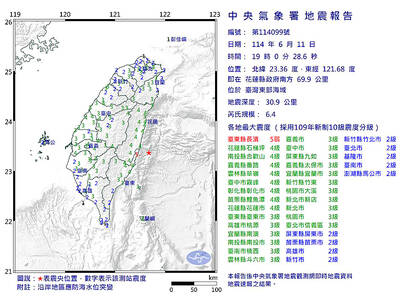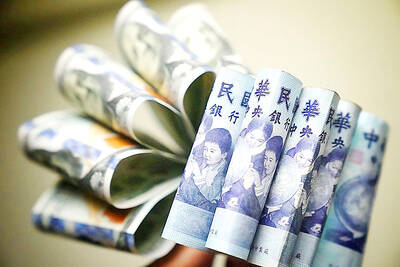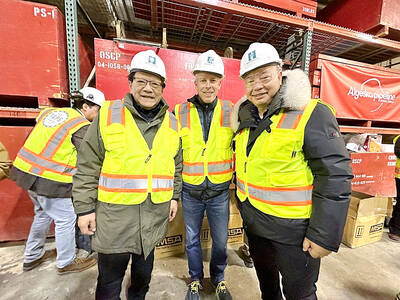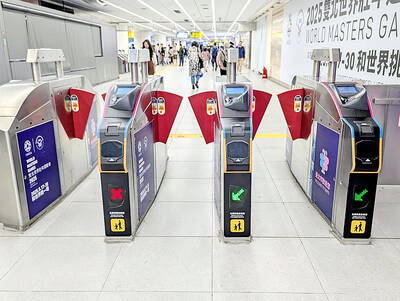A Japanese colonial-era secret tunnel near National Sun Yat-sen University in Kaohsiung’s Sizihwan (西子灣) on Saturday was opened to the public for the first time in nearly 100 years.
The Shoushan Tunnel was first excavated by Sanjiro Umino in 1927 and completed in 1928, the school said.
The tunnel, which served as a command center for Japanese forces, is spacious and properly ventilated, and has its own water, electricity, shower and housing facilities.

Photo: Hung Ting-hung, Taipei Times
The geographically advantageous base could hold 2,150 people and provided access to mountainous areas as well as the sea, and it was used for air defense, the school said.
In 1945, the Japanese fled the US Air Force’s bombing of the No. 6 Fuel Factory by hiding inside the tunnel, the university said, adding that the Port of Kaohsiung also used to have offices there.
“The secret tunnel is managed by the Kaohsiung City Government and is part of the “Hsing Pin Plan” — a heritage conservation and restoration effort by the city,” university president Cheng Ying-yao (鄭英耀) said.
Cheng said the university has a responsibility to assist the city government by providing its academic resources.
The university jumped at the opportunity to mobilize its experts in the humanities, arts and technology to showcase the tunnel’s cultural value, he added.
As part of these efforts, the school on Saturday held a special exhibition on the history of the university’s campus inside the tunnel.
The Kaohsiung Urban Development Bureau is to host a “Sizihwan School” event on Saturday and Sunday, the school added.
The bureau said it hopes that through decorative arts, the event would present a collective memory of schooling — from preschool to college — that would inspire visitors to reflect on their lives as they walk through the tunnel.

A magnitude 6.4 earthquake struck off the coast of Hualien County in eastern Taiwan at 7pm yesterday, the Central Weather Administration (CWA) said. The epicenter of the temblor was at sea, about 69.9km south of Hualien County Hall, at a depth of 30.9km, it said. There were no immediate reports of damage resulting from the quake. The earthquake’s intensity, which gauges the actual effect of a temblor, was highest in Taitung County’s Changbin Township (長濱), where it measured 5 on Taiwan’s seven-tier intensity scale. The quake also measured an intensity of 4 in Hualien, Nantou, Chiayi, Yunlin, Changhua and Miaoli counties, as well as

Credit departments of farmers’ and fishers’ associations blocked a total of more than NT$180 million (US$6.01 million) from being lost to scams last year, National Police Agency (NPA) data showed. The Agricultural Finance Agency (AFA) said last week that staff of farmers’ and fishers’ associations’ credit departments are required to implement fraud prevention measures when they serve clients at the counter. They would ask clients about personal financial management activities whenever they suspect there might be a fraud situation, and would immediately report the incident to local authorities, which would send police officers to the site to help, it said. NPA data showed

ENERGY RESILIENCE: Although Alaska is open for investments, Taiwan is sourcing its gas from the Middle East, and the sea routes carry risks, Ho Cheng-hui said US government officials’ high-profile reception of a Taiwanese representative at the Alaska Sustainable Energy Conference indicated the emergence of an Indo-Pacific energy resilience alliance, an academic said. Presidential Office Secretary-General Pan Men-an (潘孟安) attended the conference in Alaska on Thursday last week at the invitation of the US government. Pan visited oil and gas facilities with senior US officials, including US Secretary of the Interior Doug Burgum, US Secretary of Energy Chris Wright, Alaska Governor Mike Dunleavy and US Senator Daniel Sullivan. Pan attending the conference on behalf of President William Lai (賴清德) shows a significant elevation in diplomatic representation,

The Taipei MRT is to begin accepting mobile payment services in the fall, Taipei Rapid Transit Corp said on Saturday. When the company finishes the installation of new payment units at ticketing gates in October, MRT passengers can use credit cards, Apple Pay, Google Pay and Samsung Pay, the operator said. In addition, the MRT would also provide QR payment codes — which would be compatible with Line Pay, Jkopay, iPass Money, PXPay Plus, EasyWallet, iCash Pay, Taiwan Pay and Taishin Pay — to access the railway system. Currently, passengers can access the Taipei MRT by buying a single-journey token or using EasyCard,